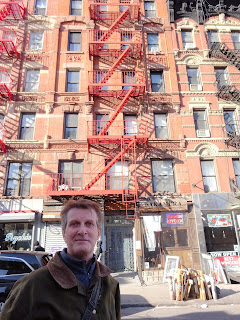"The book is completely about the evolving streetscape of New York," says Gill. "The city is constantly destroying itself. Regenerating. It's always been a city in a hurry."

Gill's inspiration for the book was a man named Ivan Karp, a self-taught gargoyle hunter who put together a team in the 1950s and led "clandestine raids on demolition sites." It was the time of Urban Renewal when countless tenements were destroyed, taking their decorations with them. Karp saved some 1,500 sculptures and eventually got the Brooklyn Museum to take them in.
Since the days of Urban Renewal, housing for low-income people doesn't come with much in the way of beauty or aliveness.
Gill and I are standing on Madison Street and Rutgers. On one side are tenements, covered in ornamentation--demon faces, cherubs, sea monsters, nudes. Their first floors are full of businesses like bodegas and Chinese restaurants. The sidewalk is busy. Across the street are the public housing towers that came out of the 1950s. They are dull and drab. Little life occurs at their feet.

Decorating tenements wasn't an act of landlord generosity--it was a marketing tool, says Gill. "The goal was not to create beauty, it was just to dress up shabby housing for the poor. It makes it look fancier than it is." Still, the decorations made for a livelier streetscape, one much less homogeneous than what we have today.
"You can feel the imprint of the individual in the object," says Gill. Then he points across the street at the housing projects. "These monstrosities are just boxes for housing low-income humans."

On the tenements, the ornaments generally come in two types: terracotta and stone. The terracotta pieces, Gill explains, were produced in a factory. The stone pieces were carved. How to tell the difference? Terracotta works tend to be sharper, while stone pieces are more likely worn away by time.
Many men among the nineteenth-century immigrants who came to New York were stone carvers. "They carved the monuments, the statues and gravestones, of Europe," says Gill, and then they carved the monuments on the faces of the tenements built for them to live in. "These gifted carvers are decorating their own housing. "
The architects didn't specify on the blueprints what decorations they wanted. "They'd just write 'carving,' and then the foreman might say 'Give me a Mary' or 'Give me a Moses,'" generic terms for a type of male and female face. "So the carver would do what he wanted. They'd carve each other's faces. Or the cop, the barkeep, or a girlfriend. So when you look up at these buildings, you're seeing the New Yorkers of the late nineteenth century looking back at you."

This stuff is in Gill's DNA. His mother, Jill Gill, was a gargoyle hunter. A self-taught artist, she painted street scenes as they were vanishing, and when she came across a forsaken ornament from a demolished tenement, she'd load it into her baby's stroller and cart it home. "My mother was obsessed about this," says Gill, but he didn't pay much attention to it in his youth.
It wasn't until he started writing for the New York Times' City Section that he "Gravitated toward historic preservation." Now, he says, "The ephemeral nature of New York's cityscape is my eternal fascination."

He wants to make it a fascination for his readers, too. "New Yorkers never look up," says Gill. And there is so much they're missing. The carvers of the past "incised their imagination onto our streetscape. They turned the streets of New York into marvelous public art galleries."
After you read The Gargoyle Hunters, you might find yourself looking up more often.
Read more about The Gargoyle Hunters and find out where John will be next





5 comments:
Flushing high school has some great gargoyles
Back in 1986 I did a short video segment on gargoyles of Manhattan.
I went around the city with my friend Andy Hoets and shot video of NYC's ornamental architecture. We, of course, interviewed Ivan Karp. And by interviewed, I mean we set the camera and Ivan held forth.
Thanks for bringing back a beautiful memory!
Here is a link to the video:
https://youtu.be/r8qMgIXjA_M
Fascinating - I look forward to reading the book. I always enjoy walking along Madison & neighboring Henry & gazing up at those figures. There's an amazing doorway on E.103rd that I keep expecting to find gone but is still hanging in there. Two old gods guarding it.
I wondered where all that stonework at the Brooklyn Museum came from - mystery solved. There used to be a lot of it on display outside - not so much now I think.
Thanks!
I have been taking photos of what I classify generally as “faces on buildings” for a few years, starting in the early 2010s. There is a particular configuration—there are a bunch of examples on West 21st Street—whose iconography I hope you can help me solve. What is the best way for me to share these pix with you, in hopes of finding an answer? I have a little info on the buildings where they appear, but . . . well, that’s it. Many thanks.
I collected tons of the ornaments from these tenements back in the 70s and early 80s, mostly from Ave A to Ave D, Houston St to 13th st but also the Bronx, Harlem and elsewhere.
I have a 300 page book with photos of long gone buildings, and the sculptures that I removed from them. I don't sell my book 'The gargoyler of Greenwich village" thru Amazon or book stores, it's only available thru me directly.
https://www.randallwolff.com/gallery/
Post a Comment